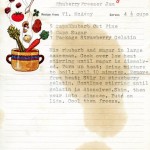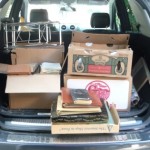
You don’t need any special equipment to preserve your heritage recipe cards, although I usually want to pull out the canning jars when I start reading old recipes. Preserving a collection of family recipe cards is similar to preserving any paper document: use archival quality materials and store in a clean, temperate environment.
Choose a storage container that suits your purpose and budget. If you want to use the cards in your everyday cooking, select a storage method that will protect the cards but allow them to be viewed. If your main goal is to preserve the cards, plan to scan and place in archival boxes with your other family documents.
Standard recipe cards are typically 3 x 5-inch or 4 x 6-inch file cards made of medium weight card stock. The paper itself is moderately acidic; not as unstable as newsprint, but not as long-lasting as 100% rag paper. Test the pH content of your cards with an inexpensive pH testing pen (available at scrapbook and art supply stores). If a swipe of the pen shows yellow ink, the card is highly acidic and you will want to give it extra care.
Use archival quality plastic protectors that have passed the Photographic Activity Test (P.A.T.) to store cards individually, or in a three-ring binder page. Look for archival sleeves and pocket page protectors at a photo supply shop or office supply store. Avery brand sheet protectors Avery Horizontal Photo Pages, Acid Free, 4 x 6 Inches, Pack of 10 (13406) made of polypropylene are an economical option.
Here are three easy recipes for preserving those family treasures:
Filebox Delight
1 standard metal or archival filebox (size for your cards)
1 set file card dividers
archival plastic card protectors
When selecting a storage box for your recipe cards avoid wood (which is highly acidic) or cardboard. Instead, choose a metal or archival box. Keep cards standing upright in the box to avoid bending and curling; use a cardboard support at the back of the box if needed.
Place each recipe in a protective plastic sleeve and file in your file box of choice. If you want to use file card dividers, use standard dividers or archival quality cut from acid-fee card stock.
If you plan to store the recipe cards in your family archive instead of your kitchen, skip the plastic sleeves and card dividers but do place the cards firmly upright in an archival file box.
Cookbook Casserole
1 3-ring binder
1 set page dividers
archival plastic photo-insert pages
You may not want to invest in an archival binder and page dividers, but acid-free plastic pages will give a good first-defense for your family recipe cards. Arrange the cards on each page and keep them clean and available in a 3-ring notebook.
Photobook Smorgasbord
1 archival photobook
A family recipe album is probably the fastest solution for storing your heirloom recipe cards. Some books feature a space to make notes about pictures; adapt this to record special comments about the recipe or cook.
Use a book sized for 4 x 6-inch size photos and you will be able to accommodate more than one size recipe card. Look for a book that will allow you to see both sides of the cards.
Bon Appetit!





